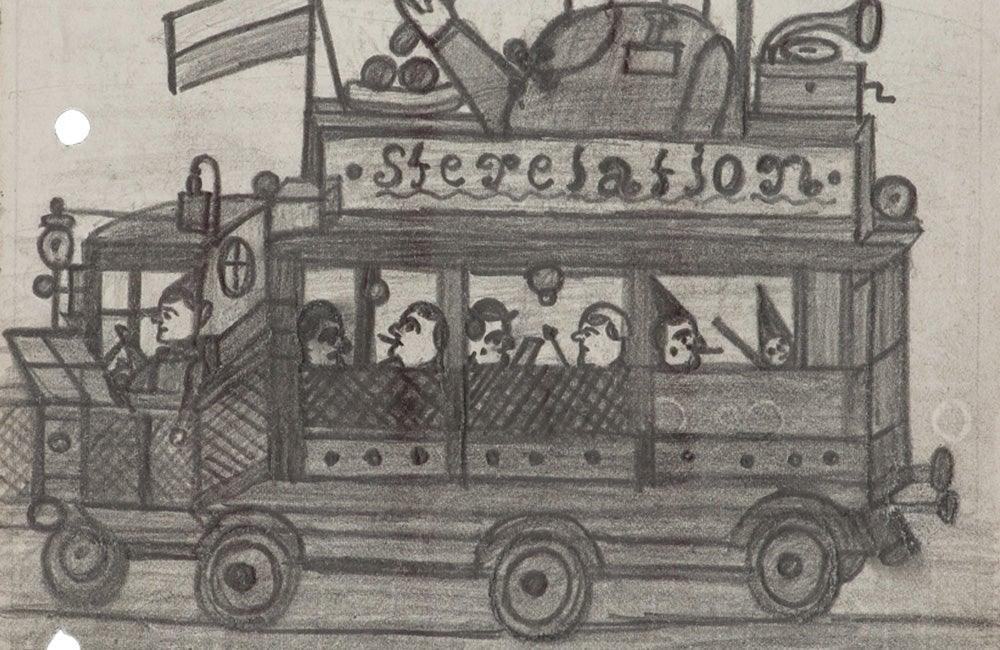First published: Fall 2018
At the end of 2008, the Prinzhorn Collection in Heidelberg, Germany, acquired from a private individual 30 small, numbered drawings dating from between 1934 and 1938 by an inmate of Werneck Asylum in Lower Franconia, Bavaria. In 2010, the Collection was able to acquire 14 more drawings by this artist from the same source, this time without numbers. They are fascinating not only because of their singular figurative aesthetics but also because they stand out as examples from a period in German history when hardly any asylum art was kept – and as unique documents on the atrocities of Nazi medicine. The author, Wilhelm Werner, was not known at all at the time, and there is hardly any information about him because his medical file has not been found. The documents that are available only reveal that he was born on September 18, 1898, admitted to Werneck Asylum in 1919 with the diagnosis of “idiocy” and transferred to an “unknown institution” on October 6, 1940. Other than these scant facts, it was noted that he was Catholic, unmarried and without a profession.
We now know that the unknown institution to which Werner was transferred in 1940 was the “Euthanasia” killing asylum Pirna/Sonnenstein. As most “transfers” were directly gassed on the day of their arrival, we probably also know the date of his death. Werner’s images are drawn on the backs of pages from a thin notebook originally intended as a shop order book. A staff member at the institution took the bundle of drawings with him when he left Werneck in 1938. He showed it to friends and acquaintances many times until his death, fascinated by the explosive nature of its content and the unique compositions of the drawings, so that the pages are worn. He also punched holes in the pages and reassembled them.

The Triumph of Sterelation (“25”), pencil on paper, 8.1 x 6.3 in. / 20.5 x 16 cm, Inv. Nr. 8083 (2008) fol. 25 recto., Prinzhorn Collection, Heidelberg
These pencil drawings are the only preserved works of art on the sterilisation of patients from the Nazi period, which started in 1934. Until now, only a few poems have remained that represent an artistic attempt to process this invasive operation affecting the core of personality, but no visual works. The drawings also indicate an immense complexity in processing these experiences with the help of original schematic renderings of people and things. For this reason alone, the diagnosis “idiocy” seems puzzling.
On the inside of the book cover, which was preserved as well, Werner refers to himself as an “orator of the people and theatre director Wilhelm Werner, Werneck Asylum”. Indeed, his drawings seem like scenes from a puppet show. The space of action is flat, the figures mostly act parallel to the plane of the image surface. Their heads are usually depicted in profile; arms and legs are only connected to the always-voluminous bodies at a single point; the hands often taking on a schematic mitten-like shape. When the figures are nude, the turning point at the outside of the shoulders can even be seen, like the split pin of a jumping jack; navel and anus are accentuated, the nipples are positioned too high up on the chest. The actors differ in dress, hairstyle, and gender: deaconesses in habits, men wearing suits, naked men, clowns with spherical bodies, partly dressed, partly naked, and naked boys.
Werner often “stages” meetings of doctors and nurses with the victims of surgery. The doctors here mainly play the part of observers and controllers, while the deaconesses manipulate the genitals of the men and boys in question. The artist’s sympathy is clearly with the seemingly helpless victims. Especially impressive are the round clowns who, although dressed as comic figures, undergo surgery with a serious face or juggle with testicle “balls.” At the same time, the “perpetrators” are not presented as unambiguously evil. “Portraits” of several men and a deaconess, depicted by Werner in half or total figure or from the knees up, exude a quiet authority. The only person whose name is mentioned in pencil, Dr Hans Weinzierl, was head physician of the surgical department in Schweinfurt from 1920 to 1945. The fact that he cooperated on the compulsive sterilisation of patients at the institution cannot be proven (the hospital files from this period no longer exist).
Even the drawing with the demonstrative title Der Siegeszug der Sterelation (“The Triumph of Sterelation” – Werner always spelled “sterilisation” incorrectly) is rather ambiguous. Was it intended sarcastically, or did Werner want to develop a humouristic fantasy about suffering for a “good cause”, referring to the propaganda vehicles that could often be seen in Nazi Germany?
This is an article extract; read the full article in Raw Vision #98




